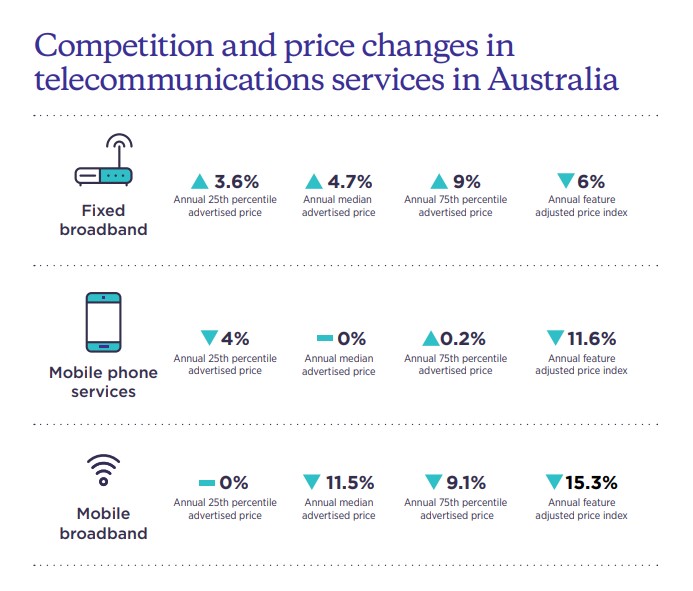Residential NBN prices have risen by as much as nine per cent over the past twelve months despite performance remaining largely unchanged, according to a new report from the Australian Competition and Consumer Commission (ACCC).
The ACCC has released its 2021-2022 Communications Market Report, which looks at developments and trends in the phone and internet sector over the past year. Alongside analysing pricing, the report also covers industry data including market share, network coverage, and which plans and services have proved the most popular with Australian consumers.
This report’s biggest takeaways include the rising average cost of NBN services across all speed tiers, and the influence of the ongoing 5G network roll out on mobile and wireless broadband pricing. We’ve taken a look at some of the key findings below.
NBN in 2022: customers paying more for the same
The ACCC found that over 2021 to 2022, advertised prices for fixed-line NBN plans increased regardless of speed tier. Basic NBN plans, which are offered on the entry-level NBN 12 speed tier, increased by 3.6 per cent, or $2.50 per month (an annual price rise of around $30). Mid-range plans rose by 4.7 per cent, or $4 per month (an increase of $48 per year), while high-end and very-high speed plans saw the biggest price increase at nine per cent, or around $9 monthly (or $108 more over 12 months).
The increase in prices for super-fast plans (e.g. NBN 250 and NBN 1000 speeds) can be attributed to the removal of NBN Co’s initial wholesale rebates, which allowed NBN providers to offer these plans at a discount. This also led to many customers switching back to slower, but more affordable speed tiers once the discounted introductory period ended, with the percentage of services on the NBN 250 tier dropping from seven per cent in June 2021, to two per cent in June 2022.
NBN 50 or Home Standard plans remain the most popular with customers, and plans with speeds of 50Mbps or faster account for 77 per cent of plans on the market (up from 69 per cent the previous year). The median advertised price for plans with speeds of 50Mbps and up was $97 per month in 2021-2022 (although cheap NBN 50 prices tend to start at around $65 per month, or $55 with discounts).

While these figures are based solely on advertised monthly prices for NBN services, the ACCC also conducts feature-adjusted pricing analysis, which takes into account factors such as increased data inclusions and improved download speeds. Using these calculations, NBN prices decreased by around six per cent year-on-year thanks to slightly-better speeds, but this is unlikely to be comforting to customers still faced with a higher monthly broadband bill.
The increased costs for entry-level customers is most concerning, particularly as the ACCC has campaigned for low-income Australians to have more affordable access to reliable internet. Basic NBN 12 plans are currently priced from around $45 per month, although six-month new customer discounts are available from many providers. However, these entry-level plans are falling in popularity, accounting for just eight per cent of the market in 2021-2022 (down from around ten per cent in June 2021).
According to the ACCC, although advertised NBN download speeds have improved across the board, upload speeds still fall short. With the post-COVID rise in Australians working from home, fast and efficient uploads are essential for video calls and large file transfers, and the ACCC has confirmed it will be keeping an eye on this key feature in the next 12 months.
It’s also possible that NBN prices will continue to creep up, as NBN Co has submitted its revised wholesale pricing proposal to the ACCC. If approved, this could lead to significant changes in how retailers pass their costs on to NBN customers, including charging higher prices for the same performance.
Related: How can I save money on my internet bill?
Compare NBN plans
Unlimited NBN 100 Plans
The following table shows a selection of published unlimited NBN 100 plans on Canstar Blue’s database, listed in order of standard monthly cost, from the lowest to highest, and then by alphabetical order of provider. Use our comparison tool above to see plans from a range of other providers. This is a selection of products with links to referral partners.
Unlimited NBN 50 Plans
The following table shows a selection of published unlimited NBN 50 plans on Canstar Blue’s database, listed in order of standard monthly cost, from lowest to highest, and then by alphabetical order of provider. Use our comparison tool above to see plans from a range of other providers. This is a selection of products with links to referral partners.
Unlimited NBN 25 Plans
The following table shows a selection of published unlimited NBN 25 plans on Canstar Blue’s database, listed in order of standard monthly cost, from the lowest to highest, and then by alphabetical order of provider. Use our comparison tool above to see plans from a range of other providers. This is a selection of products with links to referral partners.
Unlimited NBN 12 Plans
The following table shows a selection of published unlimited NBN 12 plans on Canstar Blue’s database, listed in order of standard monthly cost, from the lowest to highest, and then by alphabetical order of provider. Use our comparison tool above to see plans from a range of other providers. This is a selection of products with links to referral partners.
Mobile: 5G coverage increases, but watch your bill
In good news for regional customers, all three Aussie mobile network operators (that’s Telstra, Optus and TPG/Vodafone) extended their 5G coverage throughout the year, with an increased investment in areas outside the major cities. The big three telcos also offered wholesale 5G access to smaller providers operating on their networks, meaning 5G service is now available from a wider range of brands and at more competitive prices.
The ongoing 5G rollout has also bolstered mobile broadband and home wireless broadband’s reputations as NBN alternatives, and advertised prices for mobile broadband dropped over the past year. The median monthly mobile broadband price fell by 11.5 per cent to $35, while high-priced plans fell 9.1 per cent to $50 per month.
While the ACCC’s report found that mobile phone plan pricing was mostly unchanged through 2022, the exception was both Telstra and Optus introducing postpaid price rises mid-year. Both these price changes were accompanied by increased data allowances across plans, but did mean that each telco’s entry-level plan was still comparatively expensive, especially for customers with lower data needs.
Overall, the advertised monthly price for lower-priced plans decreased by four per cent when compared to the 2020-2021 period, settling at $24 in 2022. The median monthly price point was $35, and high-priced plans increased by 0.2 per cent to $50 per month. Postpaid plans went up in price, with median monthly costs up by eleven percent; however, median data allowances also rose, up 14 per cent to 40GB per month.
Using feature-adjusted pricing analysis, the ACCC found that customers are generally getting more data and features for their money. But with the average customer using around 10GB of data per month, and the median data allowance now at 35GB monthly on all plans, many customers may be overpaying for gigabytes they’re unlikely to ever use.
The expansion of 5G, and the increased availability of 5G capability across mid-range and affordable smartphones, means more customers will have access to faster speeds and, theoretically, require more monthly data. But there’s still a large chunk of customers with more modest data needs who shouldn’t be backed into paying extra for plan features they don’t want.
Related: How can I save money on my phone bill?
Compare SIM only mobile plans below
Here is a selection of postpaid plans from Canstar Blue’s database with a minimum of 20GB of data, listed in order of standard cost, lowest to highest, then by data allowance, largest to smallest. Try using our mobile phone plan comparison tool to see a wide range of plans from other providers. This table includes products with links to referral partners.
Here is a selection of prepaid plans from Canstar Blue’s database with a minimum of 10GB of data each month, listed in order of standard cost, lowest to highest, then by data allowance, largest to smallest. If you want to compare a larger range of offers from other providers, use our phone plan comparison tool. This table includes products with links to referral partners.


Share this article